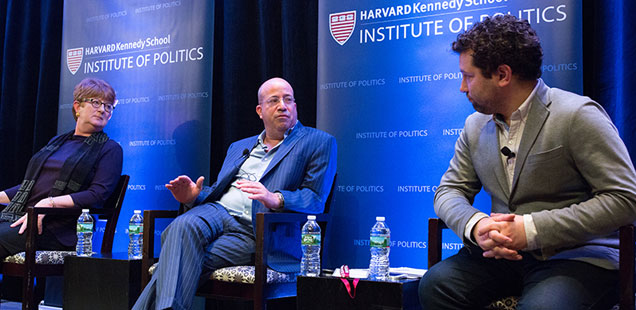Friends of the Shorenstein Center,
This week the Shorenstein Center and the Institute of Politics hosted about 70 senior campaign staff from sixteen presidential campaigns to capture a “rough first draft of history” of the 2016 presidential campaign. This week’s “Must Reads” includes a small fraction of the press coverage our event generated; there is certainly more to come. Like the campaign itself, the sessions with campaign staff of all stripes were intense, divisive, and raised significant questions about the health of our democratic institutions, especially the media. I have never been more acutely aware of the blind spots that accompany power and wealth. We’re headed into a new era in American history, and watching the media panel with Jeff Zucker of CNN, Kathleen Carroll of the AP, Marty Baron of The Washington Post, and Elliot Schrage of Facebook reinforced to me that we are in a transitional time, where our long-held assumptions about institutions, power, and the public need close examination. It is a moment not for outrage, delight, despair, or gloating, but for introspection and imagination.
Nicco Mele
Director, Shorenstein Center
This Week at the Shorenstein Center
Campaign for President: The Managers Look at 2016
NPR: Bitterness Overwhelms as Trump and Clinton Campaign Staffers Face off at Harvard.
The New York Times: CNN’s Coverage of Trump Was Biased, Presidential Candidates’ Aides Say.
The Washington Post: Shouting Match Erupts between Clinton and Trump Aides.
The Boston Globe: The Most Revealing Moments of the 2016 Race—as Told by the Campaign Managers.
Theodore H. White Seminar on Press and Politics
Earlier this month, Bob Schieffer, Walter Shorenstein Media and Democracy Fellow; Nancy Kaffer, Detroit Free Press columnist, Derrick Jackson, Joan Shorenstein Fellow; Michael Tomasky, special correspondent, The Daily Beast; and Nicco Mele, Shorenstein Center director (moderator) discussed the role of the press in the 2016 election, and what the media should consider when covering the Trump administration. Watch the video, listen to the podcast, or read the transcript.
News from Our Faculty and Fellows
White Nationalist Bigotry Is the Official Policy of Trump’s White House. Derrick Z. Jackson, fall 2016 Joan Shorenstein Fellow, writes that although conservatives “hounded African Americans from government jobs during the Clinton and Obama administrations,” in the Trump administration, “no appointment is too white, too strong.”
Fake News versus False News: Why They’re Different, and Why It Matters. Dan Kennedy, spring 2016 fellow, writes that the purpose of fake news is “to game Facebook’s (and Google’s) algorithms for profit, and is thus a worthy target of eradication efforts. False news, by contrast, is political speech,” and should be handled differently to prevent censorship.
Big Data’s Big Election Fail. Renée Loth, fall 2011 fellow, writes that micro-targeting “makes campaigns better at something voters consistently say they despise about politics: telling them only what they want to hear. “
Trump and the Rise of Populism. Pippa Norris, Paul F. McGuire Lecturer in Comparative Politics, places Trump’s win within the larger context of nationalistic movements around the globe.
Covering Trump and His Administration
Covering Politics in a “Post Truth” America, from the Brookings Institution.
Here Are 28 Ideas for Covering President-Elect Donald Trump, from Poynter.
If Trump Tweets It, Is It News? A Quandary for the News Media, from The New York Times.
The New Rules for Covering Trump, from Politico Magazine.
Media Helps Boost Donald Trump’s False Claim That ‘Millions’ Voted Illegally, from Huffington Post.
News Outlets Rethink Usage of the Term ‘Alt-Right,’ from The New York Times.
In Trump Territory, Local Press Tries to Distance Itself from National Media, from Columbia Journalism Review.
Billionaires vs. the Press in the Era of Trump, from The New York Times Magazine.
Election ’16: Lessons for Journalism, from Nieman Reports.
Where Fake News Comes from and How It Spreads
What a Map of the Fake-News Ecosystem Says about the Problem, from Fortune.
For the ‘New Yellow Journalists,’ Opportunity Comes in Clicks and Bucks, from The Washington Post.
Inside a Fake News Sausage Factory: ‘This Is All about Income,’ from The New York Times.
How Fake News Goes Viral: A Case Study, from The New York Times.
This Hyperpartisan Conservative Facebook Page Owner Says Facebook’s Fake News Plan Is ‘Terrifying,” from BuzzFeed News.
Facebook Referrals Are Crucial for Traffic to Hyperpartisan and Fake News Sites, from Poynter.
Donald Trump, Editor-In-Chief of the Fake News Movement, from Quartz.
Voter Fraud
ProPublica’s Collaborative Reporting Experiment Takes on Widespread Voter Fraud (and Finds No Evidence of It), from Nieman Lab.
Voter Fraud, Perceptions and Political Spin: Research Roundup, from Journalist’s Resource.
Press Freedom and Censorship
Maneuvering a New Reality for U.S. Journalism, from Columbia Journalism Review.
Top Journalists Warn of Threats to Press Freedom under Trump, from CNN.
Index on Censorship: Journalists Now under ‘Unprecedented’ Attack, from The Guardian
Facebook Said to Create Censorship Tool to Get Back into China, from The New York Times.
News Business
Covering the Trump Era–with Shrinking Newsrooms, from Politico Media.
Newsonomics: Canada’s Government Imagines What a News-Less Future Might Look Like, from Nieman Lab.
Sign up to receive Media and Politics Must Reads in your inbox each week. Also connect with us on Twitter and Facebook for more updates.


